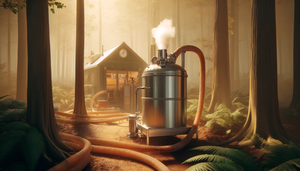Reducing Energy Consumption in Maple Syrup Production
Jul 11, 2024
Maple syrup is a cherished tradition, evoking memories of cozy breakfasts and the rich, natural sweetness that only comes from pure maple syrup. But behind every bottle of this golden delight lies an intricate process of sap collection and boiling, which, historically, has been energy-intensive. Producers have taken significant steps to reduce energy consumption in recent years, ensuring that this time-honored craft remains sustainable for future generations. This blog explores the innovative methods and technologies that maple syrup producers adopt to reduce energy use while maintaining the quality and taste we love.
The Traditional Process
Traditionally, maple syrup production involves tapping maple trees to collect sap, which is then boiled down to create syrup. This process requires a substantial amount of energy, primarily from wood or oil, to evaporate the sap's water content. For every gallon of syrup, approximately 40 gallons of sap must be boiled, making energy efficiency a crucial concern for producers.
Innovations in Sap Collection
- Vacuum Tubing Systems: Modern producers have adopted vacuum tubing systems, which help efficiently collect sap from trees. These systems reduce the labor required and enhance sap yield, reducing the number of trees needed and, thus, the overall energy consumption.
- Sustainable Tapping Practices: Producers ensure trees remain healthy and productive for years by implementing sustainable tapping practices. Using smaller taps and rotating tapping locations helps minimize tree damage, promoting a longer lifespan and consistent sap production with less energy input.
Energy-Efficient Boiling Techniques
- Reverse Osmosis (RO): One of the most significant advancements in reducing energy consumption is reverse osmosis. RO machines filter out a large portion of water from the sap before it reaches the evaporator, significantly reducing the boiling time and energy required. This technology can cut energy usage by up to 75%.
- Efficient Evaporators: Modern evaporators are designed to maximize energy efficiency. Innovations such as pre-heaters and steam recapturing systems reduce the fuel needed to boil the sap, making the process more environmentally friendly.
- Wood Pellet Boilers: Some producers have switched to wood pellet boilers, which burn more efficiently and with fewer emissions than traditional wood-fired methods. This switch reduces energy consumption and lessens the carbon footprint of maple syrup production.
Sustainability in the Sugarhouse
- Energy Audits: Conducting regular energy audits helps producers identify areas where energy is wasted and implement changes to improve efficiency.
- Solar Panels: Installing solar panels on sugarhouses can provide a renewable energy source for sap collection and boiling processes, reducing reliance on fossil fuels.
- Insulation and Sealing: Proper insulation and sealing of sugarhouses help retain heat during the boiling process, reducing the fuel needed to maintain the required temperatures.
The Impact on Flavor and Quality
Despite these technological advancements, the commitment to maintaining the flavor and quality of maple syrup remains paramount. Producers carefully balance energy efficiency with traditional methods to ensure that every syrup bottle retains the rich, wholesome taste that has made it a staple in kitchens worldwide.
Benefits of Choosing Sustainable Maple Syrup
- Environmental Impact: Supporting producers who use energy-efficient methods helps reduce the overall carbon footprint of maple syrup production.
- Economic Benefits: Energy savings translate to cost savings for producers, potentially lowering consumer prices.
- Quality Assurance: Sustainable practices ensure that maple syrup production remains viable, preserving the tradition for future generations.
Frequently Asked Questions
Q: What is reverse osmosis in maple syrup production?
A: Reverse osmosis is a process that removes a significant portion of water from sap before boiling, reducing the energy required for evaporation.
Q: How do vacuum tubing systems reduce energy consumption?
A: Vacuum tubing systems improve sap collection efficiency, yielding more sap with less energy and labor.
Q: Are there any renewable energy sources used in maple syrup production?
A: Some producers use solar panels and wood pellet boilers to reduce reliance on non-renewable energy sources.
Q: Does energy-efficient production affect the taste of maple syrup?
A: No, energy-efficient methods are designed to maintain maple syrup's traditional flavor and quality.
A: Look for producers implementing energy-efficient and sustainable practices, often highlighted on their packaging or websites.


